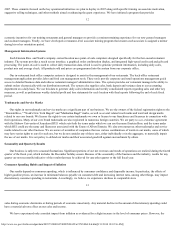Einstein Bros 2006 Annual Report Download - page 15
Download and view the complete annual report
Please find page 15 of the 2006 Einstein Bros annual report below. You can navigate through the pages in the report by either clicking on the pages listed below, or by using the keyword search tool below to find specific information within the annual report.
http://www.sec.gov/Archives/edgar/data/949373/000104746907001622/a2176540z10-k.htm[9/11/2014 10:12:36 AM]
The level of growth in comparable store sales significantly affects our overall sales growth and will be a critical factor affecting profit growth.
Our ability to increase comparable store sales depends in part on our ability to offer hospitality, attractive menu items and successfully implement
our initiatives to increase throughput, such as increasing the speed at which our employees serve each guest. Factors such as traffic patterns, local
demographics and the type, number and location of competing restaurants may adversely affect the performance of individual restaurants. It is
possible that we will not achieve our targeted comparable store sales growth or that the change in comparable store sales could be negative and
could
17
adversely impact our sales and profit growth. We expect quarterly comparable restaurant sales increases to decline throughout the year as
sequential comparisons become more difficult.
Competition in the restaurant industry is intense, and we may fall short of our revenue and profitability targets if we are unable to compete
successfully.
Our industry is highly competitive and there are many well-established competitors with substantially greater financial and other resources
than we have. Although we operate in the fast-casual segment of the restaurant industry, we also consider restaurants in the fast-food and full-
service segments to be our competitors. In addition to current competitors, one or more new major competitors with substantially greater financial,
marketing and operating resources could enter the market at any time and compete directly against us. Also, in virtually every major metropolitan
area in which we operate or expect to enter, local or regional competitors already exist. This may make it more difficult to obtain real estate and
advertising space, and to attract and retain guests and personnel.
We occupy our company-owned restaurants under long-term non-cancelable leases, and we may be unable to renew leases at the end of their
lease periods or obtain new leases on acceptable terms.
We do not own any real property, and all of our company-owned restaurants are located in leased premises. Many of our current leases are
non-cancelable and typically have terms ranging from five to ten years with two three- to five-year renewal options. We believe leases that we
enter into in the future likely will also be long-term and non-cancelable and have similar renewal options. Most of our leases provide that the
landlord may increase the rent over the term of the lease, and require us to pay our proportionate share of the cost of insurance, taxes, maintenance
and utilities. If we close a restaurant, we generally remain committed to perform our obligations under the applicable lease, which would include,
among other things, payment of the base rent for the balance of the lease term. In some instances, we may be unable to close an underperforming
restaurant due to continuous operation clauses in our lease agreements. Our obligation to continue making rental payments in respect of leases for
closed or underperforming restaurants could have a material adverse effect on our business and results of operations.
Alternatively, at the end of the lease term and any renewal period for a restaurant, we may be unable to renew the lease without substantial
additional cost, if at all. If we are unable to renew our restaurant leases, we may be forced to close or relocate a restaurant, which could subject us
to construction and other costs and risks, and could have a material adverse effect on our business and results of operations. For example, closing a
restaurant, even during the time of relocation, will reduce the sales that the restaurant would have contributed to our revenues. Additionally, the
revenue and profit, if any, generated at a relocated restaurant may not equal the revenue and profit generated at the existing restaurant. We also
face competition from both restaurants and other specialty retailers for suitable sites for new restaurants. As a result, we may not be able to secure
or renew leases for adequate sites at acceptable rent levels.
Fluctuations in the cost, availability and quality of our raw ingredients and natural resources such as energy affect our results of operations.
The cost, availability and quality of the ingredients that we use to prepare our food are subject to a range of factors, many of which are beyond
our control. Fluctuations in economic and political conditions, weather and demand could adversely affect the cost of our ingredients. We have
limited control over these changes in the price and quality of commodities, since we do not have any long-term pricing agreements for these
ingredients. We may not be able to pass through any future cost increases by increasing menu prices, as we have done in the past. We and our
franchisees and licensees are dependent on frequent deliveries of fresh ingredients, thereby subjecting us to the risk of shortages or interruptions in
supply. Additionally, in the event of massive culling of specific animals such as chickens or turkeys to prevent the spread of disease, the supply and
availability of ingredients may become limited and may dramatically
18
























